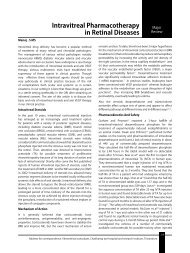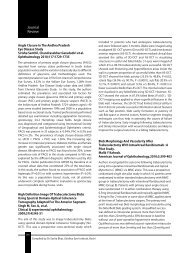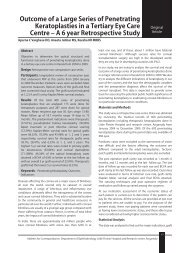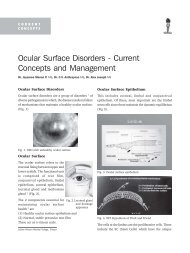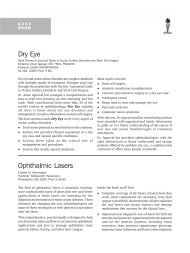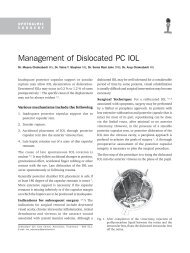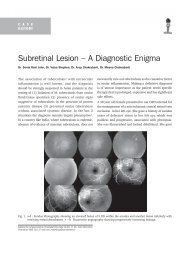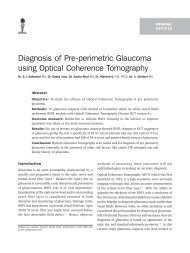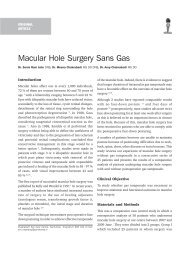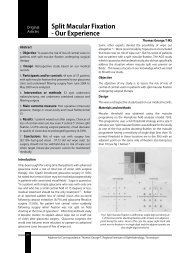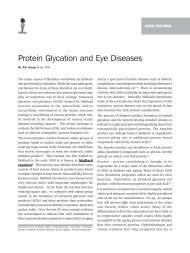Calotropis Keratitis - KSOS
Calotropis Keratitis - KSOS
Calotropis Keratitis - KSOS
You also want an ePaper? Increase the reach of your titles
YUMPU automatically turns print PDFs into web optimized ePapers that Google loves.
90 Kerala Journal of Ophthalmology Vol. XIX, No. 1<br />
C A S E<br />
REPORT<br />
<strong>Calotropis</strong> <strong>Keratitis</strong><br />
Dr. Mohammed Haneef, MS DO, Dr Manoj Venugopal, MS, DNB, FRCS Edin,<br />
Dr O U Mallika MS, DO, DNB, Dr Padma Sree K M MBBS<br />
Introduction<br />
<strong>Calotropis</strong> procera (‘Erukku’ in Malayalam) is a<br />
commonly seen shrub with a world wide geographic<br />
distribution. (Fig. 1) It is commonly harvested for its<br />
medicinal properties. It exudes copious milky sap when<br />
cut or broken. (Fig. 2) Ironically, the sap is highly irritant<br />
to human tissues especially the skin and mucous<br />
membrane 2 .<br />
This article attempts to highlight the importance of<br />
recognizing the damaging effects of this plant sap when<br />
it comes into contact with the eye and therefore the<br />
care one must take while handling this shrub.<br />
Case Report<br />
A thirty year old male who works in an Ayurvedic<br />
pharmacy presented with defective vision, redness,<br />
irritation and watering in his right eye following<br />
accidental exposure to the milky sap of <strong>Calotropis</strong><br />
(Fig 3a & 3b). (The leaf of <strong>Calotropis</strong> is used in Ayurvedic<br />
system of medicine for the treatment of joint<br />
inflammations) Another twenty four year old male<br />
presented with similar complaints in his right eye<br />
following exposure to the sap while plucking the flowers<br />
of <strong>Calotropis</strong> to make a garland out of it.(Fig 4 a & 4 b).<br />
(The garland made from <strong>Calotropis</strong> flowers is offered<br />
to the deity in temples)<br />
Department of Ophthalmology, TD Medical College, Alleppey 688001<br />
Phone no: O477 2251611 – 501 Extn<br />
Both these patients had identical findings on the slit<br />
lamp which revealed lid oedema in one of them due to<br />
contact dermatitis, circum corneal congestion,<br />
chemosis, corneal haze due to corneal oedema and<br />
numerous Descemets Membrane folds. The corneal<br />
epithelium was found to be intact. No significant<br />
AC reaction was seen.The visual acuity was<br />
CF 2M in the affected eye in the first case while it was<br />
CF 4M in the second case. IOT was within the<br />
normal range in both the eyes. Both the patients<br />
responded well to topical Prednisolone Acetate.<br />
Over a period of one week, cornea cleared well<br />
and the visual acuity improved to 6/6in both the<br />
patients<br />
Review of literature revealed that intracorneal<br />
penetration of <strong>Calotropis</strong> latex results in permanent<br />
endothelial cell loss with its morphological alteration<br />
as confirmed with confocal and specular microscopy 1 .<br />
Corneal oedema is believed to resolve well if sufficient<br />
viable endothelial cells are still present after resolution<br />
of keratitis.<br />
Conclusion<br />
We wish to improve awareness of “ <strong>Calotropis</strong> keratitis”<br />
amongst our fellow ophthalmologists , an entity which<br />
to the best of our knowledge has not been reported<br />
much in the literature.This plant due to its irritant sap<br />
can result in corneal blindness when not carefully<br />
handled.
March 2007 M. Haneef et al. - <strong>Calotropis</strong> <strong>Keratitis</strong> 91<br />
Fig 1. <strong>Calotropis</strong> shrub<br />
(a)<br />
Fig 3 a & b. Patient 1 Gross & Slit lamp microscopy<br />
(a)<br />
Fig 4 a & b. Patient 2-Gross & Slit lamp microscopy<br />
References<br />
1. ‘<strong>Calotropis</strong> Procera keratitis’: Hani S Mezaine et al<br />
Am J Ophthalmology 2004 Nov: 138: 875 – 6<br />
2. Dietmar Brandes (2005) : <strong>Calotropis</strong> procera on<br />
Fuerteventura www. bibilo.tu-bs.de/geobot/fuerte<br />
Fig 2. Sap of the plant<br />
(b)<br />
(b)



